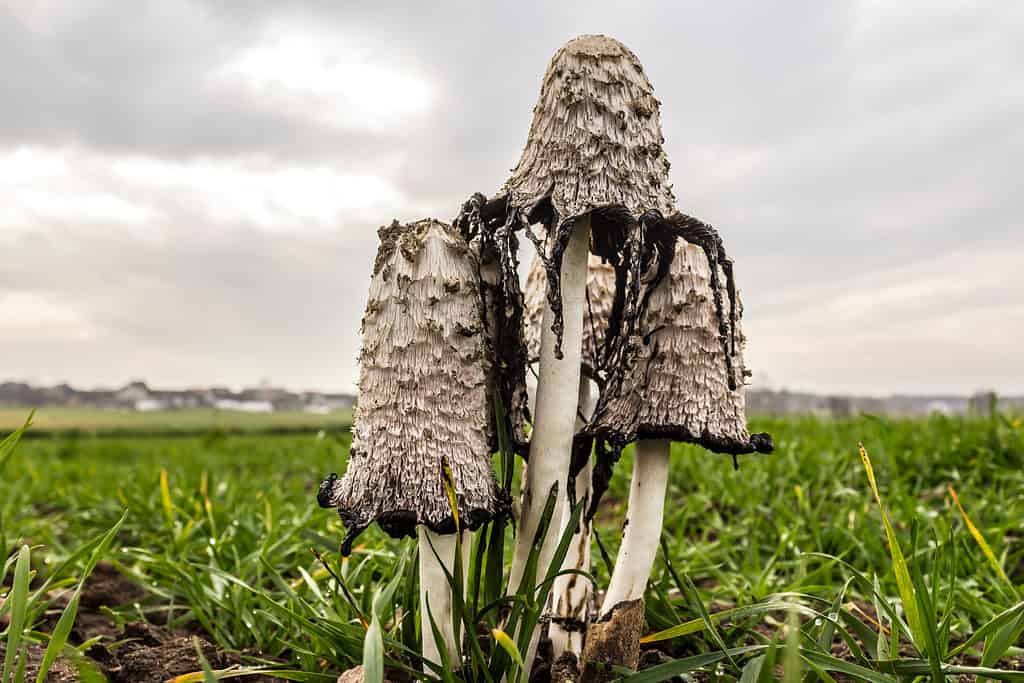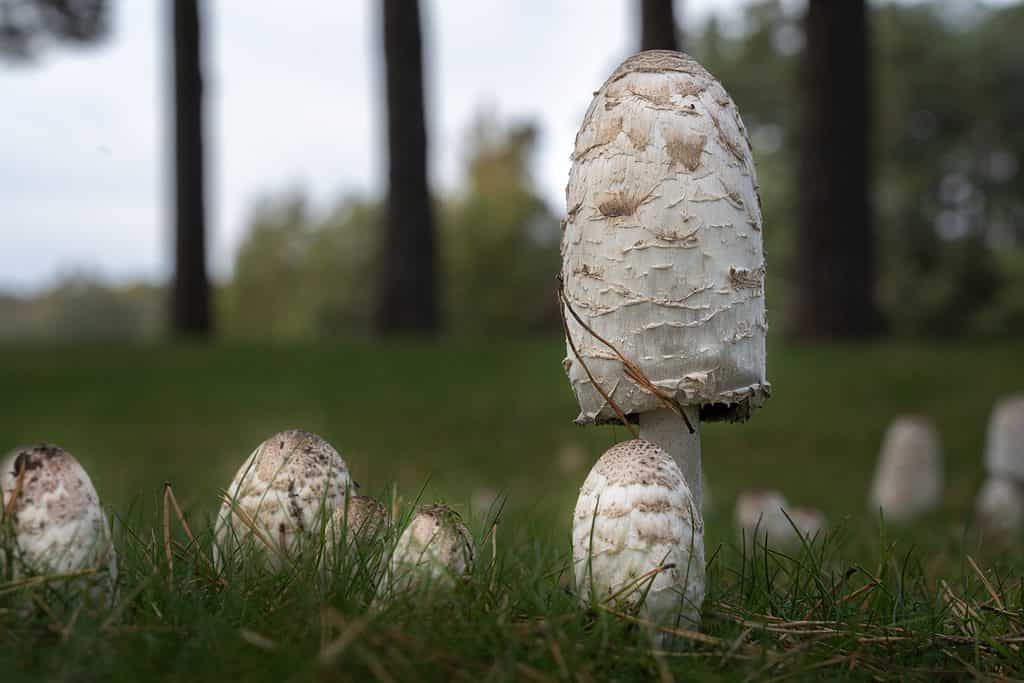It is simple to recognize, grows everywhere, and just so happens to be a fine gourmet food. We’re referring to the shaggy mane mushroom, also called the lawyer’s wig or shaggy ink cap.
The shaggy mane is a highly popular wild mushroom that frequently grows in disturbed soil along the edges of paths, on lawns, and in parks. It is the ideal species for novice foragers since it is quite simple to identify and, once you acquire a sense of it, it is instantly recognized. Of course, like with any mushroom, if you intend to consume it or serve it to others, you must be very certain of its identity.
In this article, we will study the shaggy mane mushroom, one of the greatest mushrooms to locate when foraging in the outdoors. We’ll break down its features, classification, any toxic doppelgangers, and everything else you need to know about the shaggy mane mushroom.
Information About Shaggy Mane Mushrooms
| Shaggy Mane Mushrooms | |
|---|---|
| Classification | Coprinus comatus |
| Description | A fibrous mushroom with hollow stems that have an almost wig-like appearance to its long, shaggy cap. |
| Uses | Culinary, medicinal |
| How to Grow | Sterilized grains such as rye can be used to inoculate shaggy mane spores in a liquid culture. |
| How to Forage | Look for this mushroom’s white caps in lawns or soil around late summer and early fall. |
| Key Identifying Features | The cap of this mushroom is bright white to pale brown, oblong, and covered in fibrous “hairs.” |
| Origin | Worldwide |
Shaggy Mane Mushrooms: Classification
The shaggy mane mushroom is classified as coprinus comatus. As part of the small coprinus genus, the shaggy mane mushroom is also related to a few other species, such as the coprinus calyptratus and the coprinus sterquilinus, also known as the midden ink cap.

The shaggy mane mushroom (pictured) produces a black, inky substance when it begins to self-digest.
©sheris9/Shutterstock.com
Shaggy Mane Mushrooms: Key Identifying Features and Appearance
Shaggy mane mushrooms feature conical crowns with shaggy upturned scales. The alternative term “lawyer’s wig” refers to the raised scales on their caps, which mimic the layered curls on the wigs used by attorneys in earlier courtrooms, thus the name.
When they are young, their crowns have upturned pale tan to reddish-brown scales and have a cylindrical or elongated bullet form. They usually have bell-shaped crowns that are two to six inches tall and one to two inches broad. Shaggy manes contain fibrous hollow stems with a partial veil that ranges in color from white to light brown. You should be able to see a hollow tube extending up under the cap if you cut the stem close to the ground and peek inside.
Another feature that may be used to recognize shaggy mane mushrooms is their gills. Young shaggy mane mushrooms should have white gills that are closely clustered when sliced open. The gills change color as the mushrooms grow, first turning pink, then turning black and inky as they begin to liquefy, giving rise to their alternate name, shaggy ink caps.
When these mushrooms reach maturity, they automatically digest (also known as “deliquesce”) and liquefy their caps and gills, resulting in a sticky, black material that drops to the ground. Since their gills are so densely packed, autodigestion helps them spread their spores. The process of auto-digestion begins at the edge of the cap at the bottom of the gills and moves upward. As the cap liquefies, it curls up, which aids in opening the gills and spreading the spores. Spores are also present in the inky liquid that drops to the ground, and it aids in their dispersal.
Shaggy Mane Mushrooms: Where They Grow
Foraging shaggy mane mushrooms is surprisingly easy to do. Along with morels, giant puffballs, and chicken of the woods mushrooms, many people believe shaggy mane mushrooms to be one of the most easily recognized mushrooms. This is a good thing, as there are not many mushrooms that look extremely similar to them, so accidentally picking and eating a toxic look-alike isn’t very common.
These widespread edible fungi are frequently discovered in suburban settings, making them the perfect mushrooms for novice mushroom foragers. Shaggy mane mushrooms can survive in a variety of environments, and in the summer and fall, you may frequently find them growing in suburban and urban parks, on front lawns, and along roadsides. However, you may also find them along the sides of paths and country roads, as well as in open forests and rural pastures.
Although they may grow alone, they frequently multiply after a heavy downpour and sprout in vast numbers in disturbed soil, fertilizer, wood chip piles, and even hard-packed soil.
Native to North America and Europe, saggy manes are seen all throughout the northern hemisphere. These days, they are also found in Australia, New Zealand, and Iceland. In China, shaggy mane mushrooms are grown for food.
No matter where they are, saggy manes develop quickly. Within 24 hours of the rain, they emerge, develop, and start to digest on their own. Foraging them and cooking them fast is therefore essential.

Shaggy mane mushrooms (pictured) are very unique-looking and have few potential look-alikes.
©UKSTUDIO/Shutterstock.com
Shaggy Mane Mushrooms: Potential Lookalikes
Despite the fact that shaggy manes have several distinguishing characteristics that make them simple to recognize, there are a couple of probable look-alikes you should be aware of.
Shaggy mane mushrooms and the common ink cap mushroom are sometimes mistaken for one another. They both have extended cylindrical caps when they first pop up from the earth and resemble one another greatly. However, shaggy manes get their notable wig-like scales when the caps develop. There are no similar-looking scales on the common ink cap mushroom. Additionally, compared to regular ink caps, shaggy manes frequently develop longer and stronger and typically form smaller groups. The common ink cap contains coprine, a mycotoxin that can have negative effects when mixed with alcohol, despite the fact that it is edible when young.
Although there are two kinds of mushrooms that resemble the shaggy mane mushroom in its early stages and are thought to be possible lookalikes, there is no actual shaggy mane mushroom dangerous lookalike. One is the magpie fungus, often known as the magpie inkcap. This mushroom resembles a shaggy mane in form and deliquesces to aid in spore dispersion. But magpie fungi don’t have the same appearance as shaggy scales; instead, when they are fully grown, their caps are a dark grayish-brown color with white fibrils.
Shaggy Mane Mushrooms: How They Are Used
Shaggy mane mushrooms are primarily used in cooking. However, these mushrooms may be challenging to work with in the kitchen. It’s not that they don’t taste nice; they’re delicious and, when you consider how big they can grow, kind of surreal; it’s like eating a fairy tale. The issue is that they have a very short shelf life and are delicate, making them vulnerable to damage when jostled around in a suitcase. Shaggy manes will start to get moist, mushy, and black in a matter of hours after being jostled or injured a few times.
You’ll have a great mushroom to use in your next recipe if you cook these mushrooms soon. Shaggy manes do well in buttery dishes and are delicious in recipes with parmesan, garlic, and parsley.
In addition to its use in cooking, the shaggy mane mushroom is also considered medicinal. This mushroom contains ergothioneine, a type of thiol compound that has significant antioxidant abilities. Just as well, the black inky substance produced by shaggy mane mushrooms that have already been deliquescing is actually edible and is used as a culinary dye.
Shaggy Mane Mushrooms: Where They Are Purchased
One can easily buy shaggy mane mushroom spores online to grow at home. However, it is very rare to find these mushrooms in the grocery store or any specialty store. Your best bet would be to forage these mushrooms, as there are readily available in most climates and locations.
The Shaggy Mane Mushroom Life Cycle and Behavior
This species feeds on rotting wood and other decomposing materials and spends the majority of its life in the soil as a network of cells known as mycelium. The mycelium creates mushrooms, which are reproductive structures that release spores. To start new mycelia elsewhere, the spores are discharged. When an inky cap deteriorates and liquefies, the spores are released.
How to Grow Shaggy Mane Mushrooms
Agar wedges, master grain spawn, and sterilized grain injected with liquid culture can all be used to create shaved mane spawn. For this species, sawdust spawn will not be effective. Shaggy mane mushrooms do very well on nitrogen-rich composites.
At room temperature, it will cheerfully colonize with thick, white, cottony mycelium growing tenaciously all over. After being inoculated with liquid culture or grain, grain jars should be fully colonized two weeks later; when using agar wedges, the time frame is closer to three weeks. Shaggy mane mushrooms may flourish on almost any horizontal surface, including trays, outdoor beds, bags for growing mushrooms, and more.
High humidity is ideal, however, using a casing layer will let the fruiting environment vary. Aim for a relative humidity level of between 80% and 90% throughout. On malt yeast extract agar, the culture of shaggy manes may be grown and kept for several months in the fridge.
Whether you’re growing or harvesting shaggy mane mushrooms, be sure to harvest them properly. Pick them just before the cap begins to break off from the stem. Always cut near the casing at the stem to avoid damaging the mushroom. If you plan on foraging for this mushroom, try looking for them around summer.
The shaggy mane mushroom really is a fascinating mushroom and it’s just an added bonus that it is a culinary delicacy. When foraging, just be mindful of mushrooms that may look similar to shaggy manes, and be sure to harvest them correctly.
Up Next:
- Discover 10+ Different Types of Wild, Edible Mushrooms
- 8 Different Types of Poisonous Mushrooms You Should Avoid
- The 7 Best Children’s Books About Mushrooms for Facts, Encouragement, and Foraging!
The photo featured at the top of this post is © Rita Romanyshyn/Shutterstock.com
Sources
- Michael Kuo, Available here: https://www.mushroomexpert.com/coprinus_comatus.html
- Pat O'Reilly, Available here: https://www.first-nature.com/fungi/coprinus-comatus.php
- iNaturalist Staff, Available here: https://www.inaturalist.org/taxa/47392-Coprinus-comatus
FAQs (Frequently Asked Questions)
Are shaggy mane mushrooms edible?
Yes, and they are considered a gourmet mushrooms.
When should shaggy mane mushrooms be eaten?
Young shaggy mane mushrooms are the best for cooking. Older mushrooms have caps that bruise and separate easily.
Can I eat shaggy mane mushrooms raw?
No. These mushrooms should be cooked first, and only young mushrooms should be harvested for food.
Thank you for reading! Have some feedback for us? Contact the AZ Animals editorial team.







